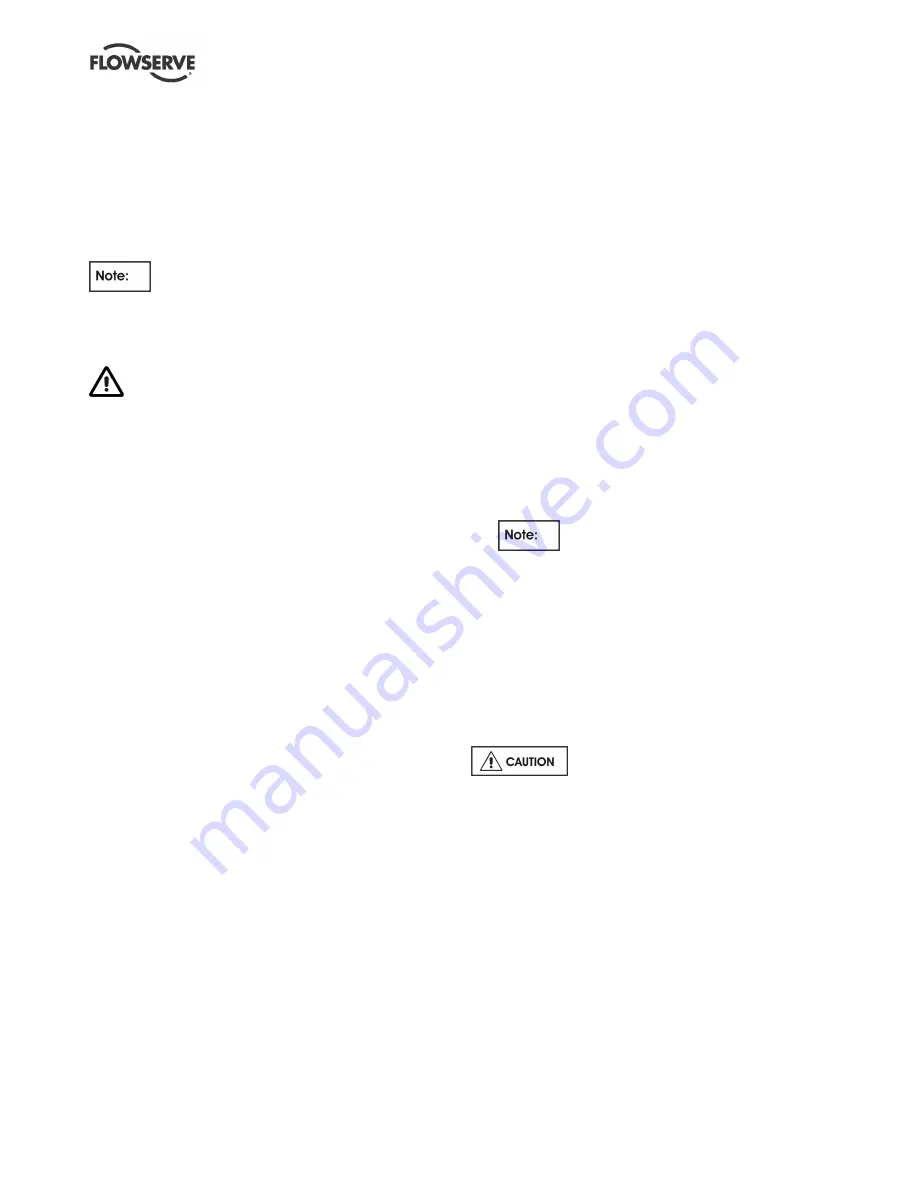
CPX, CPXR, CPXN and CPXP USER INSTRUCTIONS ENGLISH 71569117 02-10
Page 25 of 44
flowserve.com
g) Remove bearing housing assembly from pump
casing.
h) The two threaded holes in the bearing housing
flange can be used for jacking screws to assist
with removal.
i)
Remove pump casing gasket [4590.1] and
discard. A replacement gasket will be required
for assembly.
j)
Clean gasket mating surfaces.
On CPXP diffuser casing sizes it is not
normally necessary to remove the diffuser [1410,
4590.2 and 6570.5].
6.8.2 Impeller removal
NEVER APPLY HEAT TO REMOVE THE
IMPELLER. TRAPPED OIL OR LUBRICANT MAY
CAUSE AN EXPLOSION.
6.8.2.1 Impeller removal with threaded on impeller
a) Fit a chain wrench or bolt a bar to the holes in the
coupling half, or fit a keyed shaft wrench directly
to the shaft.
b) Using gloved hands, raise the wrench above the
work bench by turning the impeller [2200] clockwise
as viewed from the impeller end of the shaft.
c) Give the impeller a quick turn counter-clockwise
to strike the wrench handle against the work
bench surface or a wooden block. This will free
the impeller from the shaft.
d) The loosened impeller has an O-ring [4610.1]
that should be discarded. Use a new O-ring for
assembly.
6.8.2.2 Impeller removal with key drive impeller
a) Remove impeller nut [2912.1/2912.2] complete with
O-ring [4610.5], which should be discarded. (A new
O-ring will be required for assembly.)
b) Pull impeller off shaft.
c) Remove impeller key [6700.2].
d) Remove impeller sealing gasket [4590.4] and
discard. (A new sealing gasket will be required for
assembly.)
6.8.3 Cover [1220] and seal [4200]
The seal manufacturer's instructions should be followed
for dismantling and assembly, but the following
guidance should assist with most seal types:
a) Remove shaft guard.
b) Remove the seal gland nuts, if a separate seal
gland is fitted, and slide the seal gland away.
c) Remove the cover screws.
d) Loosen the grub screws (used in most
mechanical seals).
e) Carefully pull off the gland and mechanical seal
rotating element(s).
f) Remove the seal cover [1220].
g) Remove shaft sleeve [2400] (if fitted).
h) On non-cartridge seals the stationary seat
remains in the cover with its sealing member.
Remove only if damaged or worn out.
i)
On pumps fitted with gland packing, the packing
and lantern ring should be removed only if the
packing is to be replaced.
6.8.4 Bearing housing
a) Pull off the pump half of the coupling and remove
the coupling key.
b) Remove support foot [3134] (if necessary).
c) Remove the pump side liquid flinger [2540.2] and/or
labyrinth seal rotary half (depending on option fitted).
d) Slacken the nuts and remove bearing carrier screws.
e) Tighten bearing carrier jacking screws evenly to
initiate bearing carrier release.
f)
Remove bearing carrier and shaft assembly from the
bearing housing by pulling it towards the coupling end.
g) Remove bearing circlip (or bearing carrier locking
ring if paired angular contact bearings are fitted).
Bearing carrier locking rings are left-
hand thread.
h) Remove drive side liquid flinger and/or labyrinth
seal rotary half (depending on option fitted).
i)
Remove bearing carrier.
j)
Remove pump side bearing.
k) Release the self locking drive side bearing nut
and remove drive side bearing.
l)
When pressing bearings off the shaft, use force
on the inner race only.
6.9 Examination of parts
Used parts must be inspected before
assembly to ensure the pump will subsequently run
properly. In particular, fault diagnosis is essential to
enhance pump and plant reliability.
6.9.1 Casing [1100], cover [1220] and impeller
[2200]
Inspect for excessive wear, pitting, corrosion, erosion
or damage and any sealing surface irregularities.
Replace as necessary.
6.9.2 Shaft and sleeve (if fitted) [2200, 2400]
Replace if grooved or pitted. With the bearing
mounting diameters (or bearing outer) supported by
V-blocks, check that the shaft runouts are within
0.025 mm (0.001 in.) at the coupling end and
0.050 mm (0.002 in.) at the impeller end.
















































